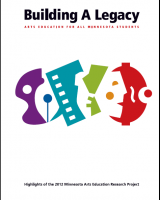Building A Legacy: Arts Education for All Minnesota Students
GENERAL
In the early 2000s, there was considerable discussion about the role of the arts in public education, but little data about the status of arts education in all schools in Minnesota. To answer this need, the Perpich Center for Arts Education launched The Minnesota Arts Education Research Project during the 2010/2011 school year with funding provided by the Minnesota State Legislature through its Arts and Cultural Heritage Fund of the Clean Water, Land, and Legacy Amendment.
The purpose of this project was to gather, evaluate and disseminate quantitative data regarding arts education in the state. The Research Project was designed to document arts education in every school through a statewide voluntary survey, and combine the survey findings with other information to create a 360-degree view of arts education in the state.
This report is a summary of the status of arts education, education policy and delivery. The intent is to provide decision makers and the public with a clear picture of the status of arts education in Minnesota. [Introduction, p. 2]
Access to Minnesota arts programs is near universal (99%) for all schools. 92% of elementary, 77% of middle, and 49% of high-school students participate in at least one arts area in one year, with music and visual arts having the highest enrollments. 92% of schools use licensed arts teachers as the primary provider of music and visual arts instruction, and 87% of schools have aligned their curriculum with the state arts standards. Additionally, 93% of schools reported providing students field trips to museums, theatres, music performances, and exhibitions. Although Minnesota has some of the strongest arts education policies in the country, implementation of these policies at the school level is uneven and need to be accounted for. Less than half of all middle and high-schools and only 28% of elementary schools provide the required number of arts areas, and the use of Licensed Arts Teachers for dance and theatre lags well behind music and visual arts. Actual student participation lags in some areas, and limited financial resources supporting arts education creates a reliance on external funding and/or additional student extracurricular fees. Additionally, 75% of schools report having no arts coordinator in their school or district. Arts integration is well accepted but not practiced regularly. Despite these gaps, nearly half of all high-schools include the arts in School Improvement Plans. Minnesota is the only state in the nation with a dedicated state agency supporting arts education, the Perpich Center for Arts Education.
BIBLIOGRAPHY






